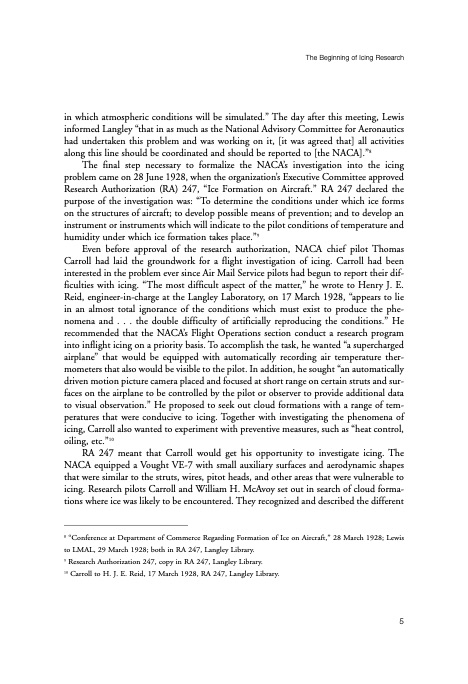
PDF Publication Title:
Text from PDF Page: 018
in which atmospheric conditions will be simulated.” The day after this meeting, Lewis informed Langley “that in as much as the National Advisory Committee for Aeronautics had undertaken this problem and was working on it, [it was agreed that] all activities along this line should be coordinated and should be reported to [the NACA].”8 The final step necessary to formalize the NACA’s investigation into the icing problem came on 28 June 1928, when the organization’s Executive Committee approved Research Authorization (RA) 247, “Ice Formation on Aircraft.” RA 247 declared the purpose of the investigation was: “To determine the conditions under which ice forms on the structures of aircraft; to develop possible means of prevention; and to develop an instrument or instruments which will indicate to the pilot conditions of temperature and humidity under which ice formation takes place.”9 Even before approval of the research authorization, NACA chief pilot Thomas Carroll had laid the groundwork for a flight investigation of icing. Carroll had been interested in the problem ever since Air Mail Service pilots had begun to report their dif- ficulties with icing. “The most difficult aspect of the matter,” he wrote to Henry J. E. Reid, engineer-in-charge at the Langley Laboratory, on 17 March 1928, “appears to lie in an almost total ignorance of the conditions which must exist to produce the phe- nomena and . . . the double difficulty of artificially reproducing the conditions.” He recommended that the NACA’s Flight Operations section conduct a research program into inflight icing on a priority basis. To accomplish the task, he wanted “a supercharged airplane” that would be equipped with automatically recording air temperature ther- mometers that also would be visible to the pilot. In addition, he sought “an automatically driven motion picture camera placed and focused at short range on certain struts and sur- faces on the airplane to be controlled by the pilot or observer to provide additional data to visual observation.” He proposed to seek out cloud formations with a range of tem- peratures that were conducive to icing. Together with investigating the phenomena of icing, Carroll also wanted to experiment with preventive measures, such as “heat control, oiling, etc.”10 RA 247 meant that Carroll would get his opportunity to investigate icing. The NACA equipped a Vought VE-7 with small auxiliary surfaces and aerodynamic shapes that were similar to the struts, wires, pitot heads, and other areas that were vulnerable to icing. Research pilots Carroll and William H. McAvoy set out in search of cloud forma- tions where ice was likely to be encountered. They recognized and described the different The Beginning of Icing Research 8 “Conference at Department of Commerce Regarding Formation of Ice on Aircraft,” 28 March 1928; Lewis to LMAL, 29 March 1928; both in RA 247, Langley Library. 9 Research Authorization 247, copy in RA 247, Langley Library. 10 Carroll to H. J. E. Reid, 17 March 1928, RA 247, Langley Library. 5PDF Image | History of NASA Icing Research Tunnel

PDF Search Title:
History of NASA Icing Research TunnelOriginal File Name Searched:
sp4226.pdfDIY PDF Search: Google It | Yahoo | Bing
NFT (Non Fungible Token): Buy our tech, design, development or system NFT and become part of our tech NFT network... More Info
IT XR Project Redstone NFT Available for Sale: NFT for high tech turbine design with one part 3D printed counter-rotating energy turbine. Be part of the future with this NFT. Can be bought and sold but only one design NFT exists. Royalties go to the developer (Infinity) to keep enhancing design and applications... More Info
Infinity Turbine IT XR Project Redstone Design: NFT for sale... NFT for high tech turbine design with one part 3D printed counter-rotating energy turbine. Includes all rights to this turbine design, including license for Fluid Handling Block I and II for the turbine assembly and housing. The NFT includes the blueprints (cad/cam), revenue streams, and all future development of the IT XR Project Redstone... More Info
Infinity Turbine ROT Radial Outflow Turbine 24 Design and Worldwide Rights: NFT for sale... NFT for the ROT 24 energy turbine. Be part of the future with this NFT. This design can be bought and sold but only one design NFT exists. You may manufacture the unit, or get the revenues from its sale from Infinity Turbine. Royalties go to the developer (Infinity) to keep enhancing design and applications... More Info
Infinity Supercritical CO2 10 Liter Extractor Design and Worldwide Rights: The Infinity Supercritical 10L CO2 extractor is for botanical oil extraction, which is rich in terpenes and can produce shelf ready full spectrum oil. With over 5 years of development, this industry leader mature extractor machine has been sold since 2015 and is part of many profitable businesses. The process can also be used for electrowinning, e-waste recycling, and lithium battery recycling, gold mining electronic wastes, precious metals. CO2 can also be used in a reverse fuel cell with nafion to make a gas-to-liquids fuel, such as methanol, ethanol and butanol or ethylene. Supercritical CO2 has also been used for treating nafion to make it more effective catalyst. This NFT is for the purchase of worldwide rights which includes the design. More Info
NFT (Non Fungible Token): Buy our tech, design, development or system NFT and become part of our tech NFT network... More Info
Infinity Turbine Products: Special for this month, any plans are $10,000 for complete Cad/Cam blueprints. License is for one build. Try before you buy a production license. May pay by Bitcoin or other Crypto. Products Page... More Info
| CONTACT TEL: 608-238-6001 Email: greg@infinityturbine.com | RSS | AMP |